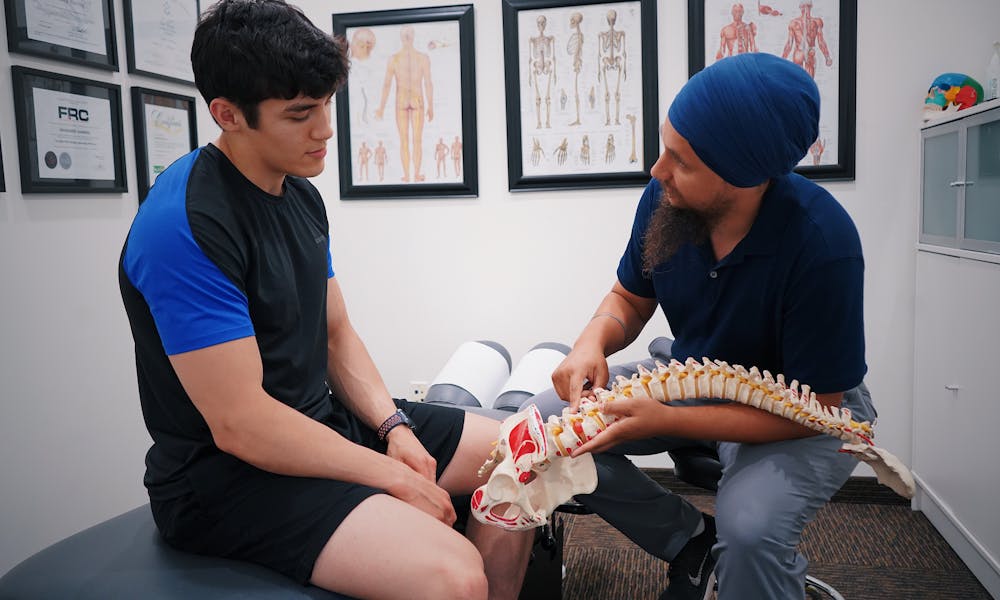Workspaces shift but our need for a healthy, supportive office chair remains. Lumbar support is the cornerstone, aligning your spine and posture for optimal comfort and well-being. Let’s explore how to position lumbar support on ergonomic chair and find out its impact on your daily life.

What is Lumbar Support?
Five vertebrae curve inward at our core, forming the lumbar spine. Though it might seem ordinary, this bend plays an important role in spinal health.
In an office chair, proper lumbar support mirrors this curve, easing the strain on your lower back. Imagine a hunched worker, oblivious to the tension building in their spine. Without support, that tension accumulates, potentially leading to long-term back issues.
In this digital age where sitting reigns supreme, lumbar support isn’t a perk but a necessity. It is a buffer, shielding you from postural problems that can morph into chronic pain or worse. It’s not just about posture, though; proper support directly impacts comfort and productivity. Focus on that deadline, not nagging discomfort.
The best office chair should not only grace your space; it should embrace you, supporting you where it truly matters.

Steps on How to Position Lumbar Support on the Ergonomic Chair Correctly
Ready to banish back pain and unlock the full potential of your office chair? Let’s delve into the art of positioning your lumbar support, transforming your workspace into a haven of comfort and productivity.
Before we begin, a quick note: These tips are specifically tailored for chairs with adjustable lumbar pads.
1. Find the Natural Curve of Your Spine
Perch on the edge of your chair, feet planted firmly below. Now, gently rock your pelvis back and forth. Can you feel the subtle shift? That’s your spine settling into its natural, comfy curve – your lumbar sweet spot.
2. Adjust the Height and Depth
With your sweet spot located, reach for your chair’s lumbar height adjustment. Think of it as a gentle hug, filling the curve of your lower back without pushing you forward. Some chairs let you adjust the depth too, so don’t hesitate to play until you find that perfect, “just right” fit.
Adjusting your chair height according preference targets not only the lumbar section but the hip area as well.
3. Test and Retest
Finding the perfect lumbar position is like crafting the ideal cup of tea – a touch of exploration with a dash of patience. Give it a day or two and listen to your body. Still fidgeting or feeling the aches we mentioned before? Time to make some adjustments.

Tips for Unique Posture Needs
For those with pre-existing back concerns or unique postural needs, a standard office chair might not always provide the optimal support. This is where adjustable lumbar cushions come in, offering personalised comfort and tailored spinal alignment.
Think of it like building your ergonomic dream team. A good chair provides the foundation while an adjustable lumbar cushion becomes the customisable element, filling in the gaps and ensuring proper spinal curvature.
Your Lumbar Support Needs Adjustment When These Five Signs Appear
The end of the workday should not usher in a feeling of carrying an undue physical weight. Nevertheless, subtle but telling indicators, such as postural shifts or persistent lower back discomfort, can suggest misalignment of your lumbar support.
Here are the telltale signs that your lumbar support needs adjustment:
1. Misaligned Shoulders
When your shoulders sit directly over your hips, the weight is distributed evenly, leading to optimal comfort and support. But if one side dips lower, it’s like adding an extra weight on that side, throwing your spine out of alignment.
2. Frequent Shifts in Seating
Inability to maintain a comfortable seated position or experiencing leg numbness may suggest inadequate lumbar support.
3. Chronic Back Issues
Failure to address these early indicators could, over time, manifest in chronic lumbar pain or disc herniation, posing a substantial impediment to daily life.
4. Forward Leaning Tendency
Subtle shifts in your posture, such as an unconscious forward lean or a slouched position, may indicate that your lumbar support needs adjustment.
5. Pronounced Lower Back Pain
One readily apparent sign suggesting the need for adjustment of your lumbar support is the occurrence of chronic lower back discomfort.

Why Seat Depth Matters for Lumbar Support
The depth of your seat critically influences the interaction between your hips, thighs, and lower back with the chair. An insufficient depth can lead to a precarious “perched on the edge” feeling, while excessive depth may prevent your lower back from establishing optimal contact with the lumbar support.
To achieve optimal seat depth, your back should rest firmly against the lumbar support while maintaining a small gap (approximately the width of a clenched fist) between the seat pan and the back of your knees. This configuration ensures both proper support and comfortable leg extension.
Different Materials Used in Lumbar Support
Foam: Renowned for their adaptability, foam supports seamlessly mold to the unique curvature of the spine, delivering uniform support and alleviating pressure points. Their inherent durability and comfort make them a favored option for those seeking sustained lumbar support.
Mesh: Fabricated for optimal breathability, mesh supports provide a refreshing solution for individuals in hot environments or those prone to heat build-up. Their structure allows for consistent and firm support across the lumbar region, fostering proper posture and mitigating discomfort.

Tips for Enhancing Lumbar Comfort
Optimising lumbar comfort in the workplace need not be a daunting task. This guide dispels the confusion surrounding office ergonomics and offers practical strategies, extending beyond chair adjustments, to ensure a pain-free and thriving lumbar region.
- Exercises and Stretches
Integrating targeted exercises and stretches into your routine can significantly enhance your lumbar health. Harvard Health encourages core strengthening exercises for a healthier and stronger back. Regularly practicing the “cat-cow” yoga pose and pelvic tilts promotes spinal flexibility and mobility, reducing tension and discomfort.
Furthermore, incorporating core-strengthening exercises, such as planks, provides additional support and stability for your lower back, improving posture and preventing future issues.
- Periodically Changing Sitting Positions
Maintaining a single posture, even an ergonomically configured one, can be detrimental to long-term lumbar health. Prolonged sitting periods without regular muscle contractions can increase back muscle stiffness, which may contribute to musculoskeletal disorders such as low back pain.
This is according to a paper entitled “Sitting for Too Long, Moving Too Little: Regular Muscle Contractions Can Reduce Muscle Stiffness During Prolonged Periods of Chair-Sitting” by Alexander Kett, Thomas Milani and Freddy Sichuan from Chemnitz University of Technology in cooperation with Mercedes-Benz.
Therefore, incorporating dynamic sitting practices into your workday routine is key. Implementing minor position changes every 30 minutes, like simple crossed-leg swapping, facilitates pressure redistribution and prevents the development of localised discomfort.
Mistakes to Avoid in Lumbar Support Positioning
While ergonomic chairs and lumbar support promise back bliss, improper positioning can turn that promise into pain. Let’s explore common missteps to ensure your lumbar support is your back’s best friend, not its silent saboteur.
1. Overcompensating
Striking a balance is crucial when it comes to lumbar support. While insufficient support can lead to discomfort, excessive support can paradoxically misalign the spine.
To achieve optimal ergonomic positioning, strive for a sensation of natural support, where your back rests comfortably against the lumbar curvature without experiencing any undue pressure or deviation from its neutral posture.
2. Using Lumbar Support in Isolation
Lumbar support plays a pivotal role in back comfort but it should not be viewed as a standalone solution. To maximise its effectiveness, it must be integrated into a comprehensive ergonomic chair setup.
3. Ignoring Regular Readjustment
Our bodies and postural needs are subject to continual change. What felt perfectly supportive a month ago may now require refinement. Cultivating the habit of periodically reevaluating your lumbar support configuration empowers you to proactively maintain proper spinal alignment and prevent potential discomfort.

What to Consider When Purchasing a New Office Chair
Choosing the right office chair requires careful consideration, as the spectrum of quality and features can be daunting. When embarking on this search, focusing on chairs equipped with adjustable lumbar support, such as our Ergonomic Chair, is imperative.
This strategic investment in your well-being translates to significant positive long-term outcomes, promoting both a comfortable working experience and optimal postural alignment.
Conclusion
Taking the time to adjust your lumbar support isn’t simply about feeling good today; it’s about setting yourself up for a pain-free tomorrow. By providing your back with the optimal support it deserves, you proactively cultivate a healthy posture and prevent potential musculoskeletal issues from developing.
- 6 Benefits of Using Seat Cushion - February 20, 2024
- 4 Tips to Fix Uncomfortable Chair - February 19, 2024
- How to Position Lumbar Support on Ergonomic Chair - February 15, 2024

